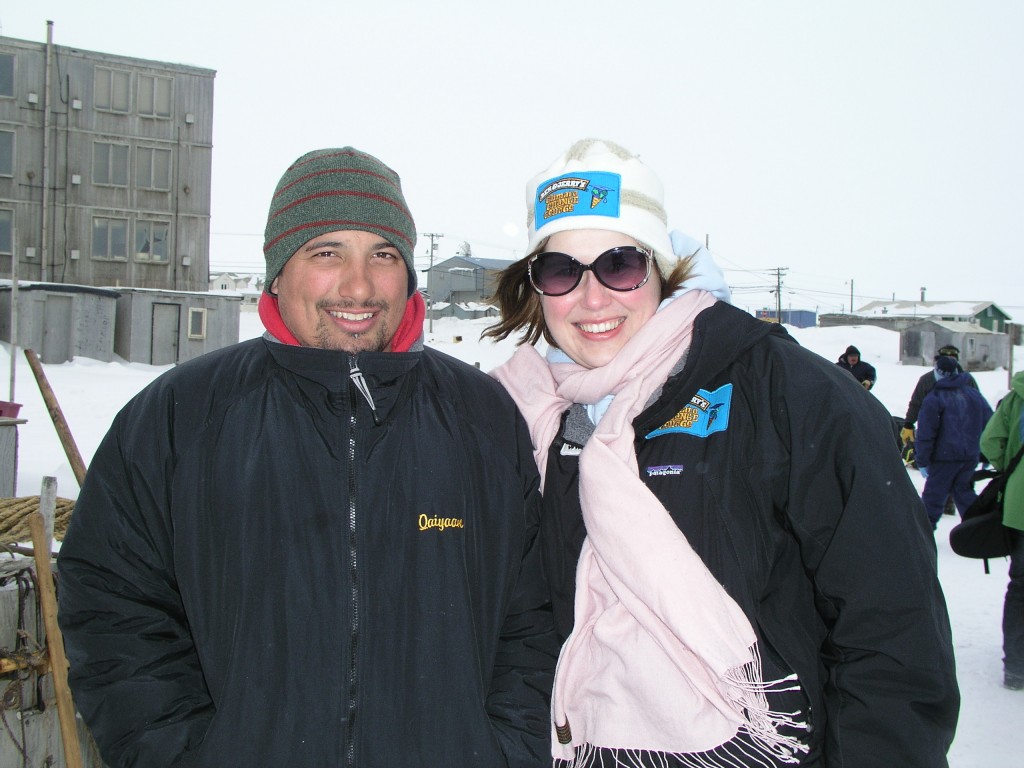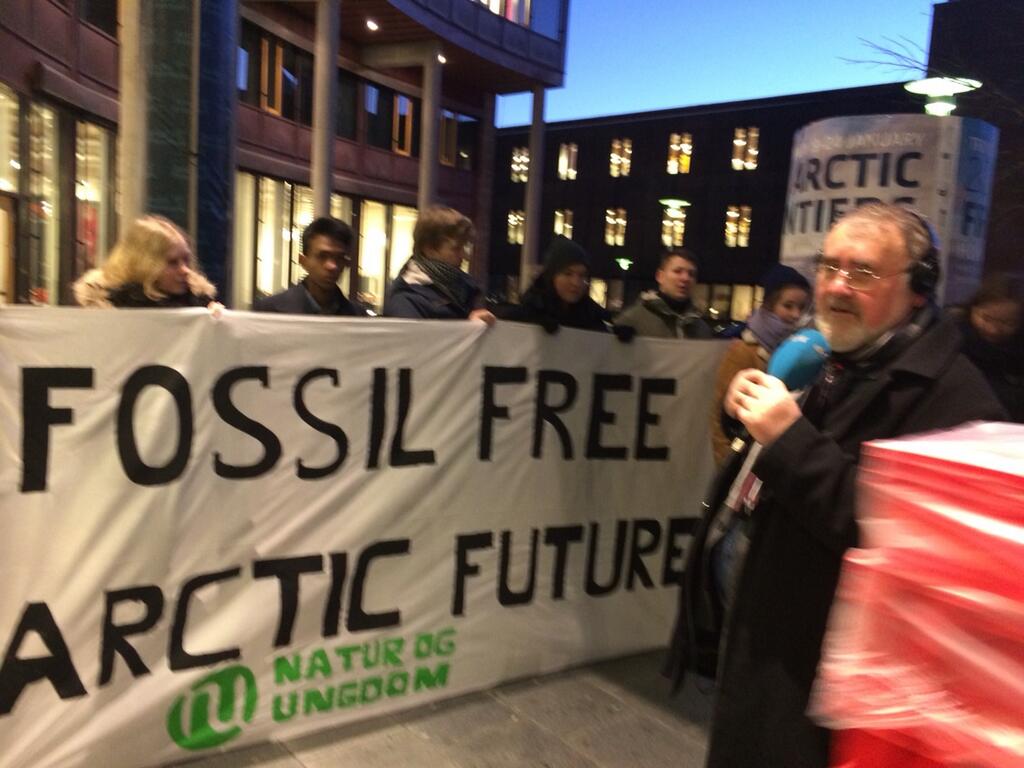Search Results for Tag: Inupiat
Empowering Arctic Youth

Cara and Kayan – “Give me a solar-powered snow mobile and I’ll use it” was the young Eskimo’s quip in Barrow, Alaska, in 2008.
Back in 2008, the Ice Blog was born when I was on a trip to Alaska reporting on the “Climate Change College”, a joint project by WWF and an ice cream company to interest young people in climate change. Young climate ambassadors from Europe had won a trip to Arctic Alaska to find out first hand about the impacts of climate change – and to meet with young people in the region. I am still in contact with some of the ex-ambassadors, who are continuing to make contributions to climate and environment protection in their careers and everyday lives. Cara Augustenborg in this photo is a successful academic, entrepreneur and Green Party candidate in Ireland. Kayan, I wonder if you are still in Alaska and if you ever got yourself an environment-friendly means of transport?
Anyway, I have Elías Thórsson from the Arctic Journal to thank for drawing my attention to a new youth project inside the Arctic: YAC, the Youth Arctic Coalition. It sees itself as “Youth collaboration to address environmental, economic and social challenges and opportunities in the Arctic”. The latest edition of the Arctic Journal has a story by Elías on the group and the need to include young people in decisions on Arctic issues, headlined “Carpe Arcticum”.
Indeed, the Arctic is one of the fastest changing places on the planet. With countries as far away as China or Japan making their interest(s) plain, what happens in the Arctic today will have a huge impact to the region future generations in the High North will inherit.
During my latest visit to Arctic Norway in January, young protesters in Tromso told me of their fears about the environmental impacts of Arctic oil drilling. During visits to Alaska, I spoke to young Inupiat residents who were more concerned about jobs and hoping to continue to benefit from wealth from the oil industry. In Greenland, some of the youngsters I spoke to were torn between concern about the melting ice and changes to the lifestyle they had grown up with, and the hope that climate change might bring jobs and prosperity to their Arctic island.
The YAC, which held its inaugural conference in February, is trying to bring young people from across the Arctic together to have their say in what is happening. It is not an easy task, as Elías explains in the article. Clearly, views amongst young people will cover as wide a spectrum as those of any other generation. But they will be united in their interest in looking beyond the short-term interests which influence business and politics today.
So good luck to YAC and here’s hoping your organization will attract a lot of interest. And that it will inspire a lot of active participation to shape a sustainable future for the Arctic and represent the interests of coming generations in a region in danger of losing its identity amidst the ever-faster changes caused by a warming climate.
G’donya Cara!
The World Bank has been running a short film/video competition on the subject of the Social Dimensions of Climate Change.
Cara Augustenborg from Ireland is in 9th place with a short film she made on the Inupiat in Barrow, Arctic Alaska. (Sound familiar? Yes, she was one of the Climate Change College ambassadors I accompanied to Arctic Alaska, the birthplace of the Ice Blog).
Social Responsibility competition, with the short-listed filma

Cara (green do-it-your-selfer in the green helmet)with Aart and Erika, filming for their projects in Alaska
And here’s a link to Cara’s site
Arctic Update from Johannes

Johannes, 16.06.2008
Before answering the questions readers of our blogs raised, I want to give you a quick summary of today.
Our 6th day started as usual, with a lecture, this time Solitair Townsend, a communication-trainer from London, told us how to talk to leaders in politics and business. I think that was quite important, because we all want leaders using their power for combating global warming.
In the afternoon we landed at Snatcherpynten, Recherchefjord and walked up to a moraine of the Renard Glacier. We climbed the glacier and had a magnificent view of this nature.

In the evening the crew of the ship prepared a surprise: we had a barbeque (!) in front of a great landscape with glaciers and high snow covered mountains. While eating we just had nice conversations and enjoyed the sunshine.
But now I want to answer your questions:
“Gerry B” asks which “submarine” we used and if it is something special about the Arctic.
I think you have seen the photos of our first Onboard-Day. On this day (Wednesday) we had a safety and lifeboat drill. So we had to embark in the narrow lifeboats, which probably on the photos look like submarines.
Gerry B also wanted to know whether we had special fitness training and tests.
Although some trips are a bit exhausting, we did not partake in fitness trainings or test. When we applied for the voyage there was only the note that every participant has to be healthy and fit enough to go to the Arctic.
Ann likes to see photos of the seal and the reindeer(s).
Unfortunately we currently do not have the communication possibilities to load up extra pictures. But as soon as we are back in “internet territory” we will make sure to show you more pictures. Until then check out
Pictures on German blog
– our German blog for more photos.
“Tom” wants to know why the Sami are suffering from global warming and why they aren’t happy about things warming up.
As I/ we already mentioned in the blog the Sami have several problems probably caused by global warming. Let me give you an example which was given to us by the Sami Olav Mathis Eira, reindeer-herder from North Norway. In the 1990s several times it rained during winter. The last time that happened was in 1918! This caused several problems. As the rain froze on top of the snow cover forming a thick hard layer, the reindeer where unable to dig through the snow and to find food. Furthermore reindeers had trouble to walk on the frozen rain. According to Olav Mathis Eira this probably led to a severe decrease in reindeer during the 1990s. Nearly everybody sees global warming as the cause for these incidents, which occurred several times in the last 20 years.
Another example is that oil-companies began to exploit the nature because global warming makes it easier and, of course, cheaper to use the natural resources in Norwegian and Swedish arctic regions. This industrial development destroys valuable nature and at the life of the Sami people because they depend on the intact nature here in the Arctic.
And a PS from Irene, your Ice-Blogger in the background:
The Inupiat in Arctic Alaska are another indigenous group affected by climate change, as you may have read on this blog.
If you listen in to this week’s edition of Living Planet, you can hear a feature about my visit to the Inupiat with a field trip from the Ben and Jerry’s Climate Change College.
Here’s the link
Radio Feature on the Inupiat of Arctic Alaska and Climate Change
Cara,Erika, Jakob, Aart – you’re all in that feature, you were great, and I hope you’ll be listining in!!!
Marc and Michel from the Climate Change College (currently up there in the Arctic!) – you’ll be proud of them!!
Baked Alaska Online!
My “Flash Gallery”, with Alaskan photos and information, is now online.
Baked Alaska Flash Gallery
And Deutsche Welle is currently broadcasting the first installment of the “Climate Change College in Alaska” radio feature series. You can listen online or subscribe to the podcast.
Alaskan Climate Change Series on LIVING PLANET
Cool Forecasts – a Hot Topic?

They have no doubt that the planet is warming: Arctic explorers Marc Cornelissen,head of the Climate Change College, and archaeologist Anne Jensen, who rescues historic burial sites from being washed into the sea as a result of coastal erosion. (The sea ice is a natural protection barrier. As it diminishes, the land is left more vulnerable to the elements). I took the photo at Point Barrow, the northernmost point in the USA and well into the Arctic Circle.
People here in Germany are talking about a new study published in the journal Nature last week suggesting a possible lull in man-made global warming. (More in the “eco-news” bulletin which Nina Haase wrote for this week’s Living Planet programme):
This week’s “Eco-News” by Nina Haase
Scientists and politicians are worried that this might make people think they don’t have to rush to take action after all. The study doesn’t dispute the human role in global warming, but it predicts a cooling down from recent average temperatures between now and 2015, as a result of a natural and temporary shift in ocean currents. Now, experts on the Intergovernmental Panel on Climate Change are worried that people might become relaxed again about reducing emissions. There’s no doubt about the fact that people are more likely to take action if they see clear evidence of climate change and are worried about droughts and floods.
(Ines, I thought of you this morning when I read in the paper that Barcelona is relying on tankers bringing in drinking water.)
I was on a panel at an event here in Bonn today where some of the journalists – discussing the role of the media in reporting on climate change – said doubt had been cast on the methods used in the “cooling” report anyway.
In the hope that it might convince some more undecided readers of this blog (I realize of course I could be preaching to the converted with this), I’d suggest a listen to George Divoky, a dedicated ornithologist working on Cooper Island, in the Beaufort Sea north of the Arctic town of Barrow. George has been observing guillemots for 33 years and has quite clearly seen the evidence of climate change. The interview is attached for your listening pleasure. It’s also featured in our Living Planet programme this week.

This shows climate ambassador Cara, talking to a young eskimo,Kayan, who told us he is very concerned about the warming climate and the changes to the sea ice on which the eskimo culture depends so much. Cara is also on this week’s Living Planet programme.

Trying to look at ancient burial sites at Point Barrow. This shows typical everyday working conditions for scientists and other experts trying to keep track of coastal erosion and the ancient sites in danger of disappearin there.





















Feedback